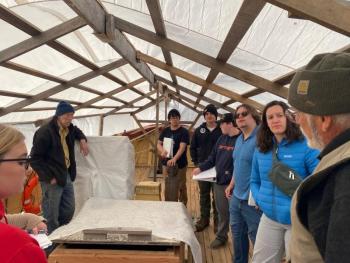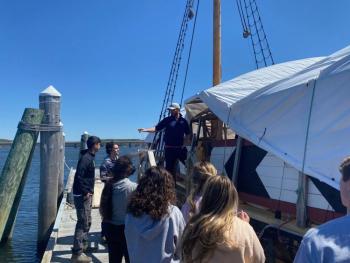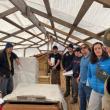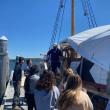WMHS studies the Virginia in Wiscasset Harbor
Wiscasset Middle High School history students researched the Virginia at Wiscasset Harbor April 22. The Virginia this one commemorates was built in 1608 at Popham Colony.
Ruth Burchstead, an AP American history student, said, “I enjoyed learning about the historical context of the Virginia ship. The Virginia was built as an exploration ship that would travel the coast of Maine to catch mainly cod to bring back to England along with lumber and fur. But instead of being an exploration ship, the Popham Colony used it to get back to England.”
Popham Colony in Phippsburg was founded in 1607 and it preceded the Plymouth Colony. The colony lasted 14 months after the death of Sir John Popham, running into financial issues and growing hostilities with the French and Abenaki.
Noah Ruzyckij learned, “The ship was meant for coastal exploration but ended up being used to get the Popham Colony settlers back home to England. The vessel felt fairly small to carry people across the Atlantic Ocean. The vessel was also meant to carry cargo and if the hull was full people would live on the deck.”
The Virginia voyage was the first documented Atlantic crossing by such a vessel so the remaining early North American settlers could return to England. In May 1609, the Virginia became part of a nine-vessel resupply convoy headed for Jamestown Colony.
Olivia Warlick shared some unique nautical features: “The history of Virginia is rich, as it was built over 400 years ago with the build of a classic English ship. The ship can take up to 40 knots of wind with gaff rig sails. The bottoms of the sails are removable, but it took a tedious process to take them off and put them back on.”
Cameron Main appreciated the modest 51-foot length of the ship. “Being on the Virginia gave me a pretty good idea of what it would have been like sailing through the ocean. Primarily how windy, cold, and rocky it would have been traveling all the way back to Europe. All the intricate details of the ship gave me an appreciation for how much work had to go into cutting and carving each individual piece. It was a very good experience.”





























